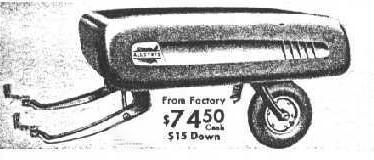
The Allstate Streamline
By the Spring–Summer 1954 Sears Catalog, a new generation of trailers was unveiled under the bold headline: “NEW! ALL-STEEL TRAILERS — Streamlined Like Cars!” This introduction marked a significant design evolution for Sears’ single-wheel trailer line. The catalog’s enthusiastic tagline, “Smartest One-Wheel Trailer You’ll See on the Road This Season!”, captured the spirit of mid-1950s American innovation—an era fascinated by modern styling and automotive influence.
This latest model carried forward many of the proven mechanical features of its predecessors, such as the reliable “knee-action” wheel assembly, the two-piece aluminum wheel, and the 500-pound load capacity that had become standard for Sears single-wheel trailers. However, the 1954 design represented a major leap forward in both materials and construction methods. It was the first Sears trailer to feature a fully pressed steel body with integrated trim pieces and a unibody construction, eliminating the need for separate wooden panels.
The sides of the trailer were enhanced with a streamlined indentation that echoed the sweeping body lines of contemporary automobiles. These indents were visually divided by five outward-pressed ridges, giving the trailer a sense of strength and motion. The bolted-on aluminum accent plates at the front of each indentation added a refined, decorative touch. Catalog images prominently displayed the “ALLSTATE” logo superimposed on a U.S. map emblem across these aluminum plates—though, interestingly, no surviving examples of this particular version with the logo have been documented. Most known plates retain a golden anodized finish but lack any visible markings, suggesting that production variations may have occurred.
Evidence indicates that this all-metal trailer was produced by Dunbar Kapple, a trailer manufacturer based in Geneva, Illinois, approximately thirty miles west of Chicago. Dunbar Kapple was reportedly partially owned by Sears, which aligns with the company’s tendency to source branded products from its affiliated manufacturers. The model number 231-963 assigned to the Allstate trailer follows Sears’ numbering convention in which the first three digits identify the manufacturer—here, the same prefix also appeared on two-wheel trailers marketed under Sears’ David Bradley agricultural line. This further supports the likelihood that Dunbar Kapple manufactured the single-wheel version as well.
For owners of the 1955 Chevrolet, Sears offered a specialized variant designed specifically for that vehicle model. While the catalog did not specify the precise differences, it is presumed that the Chevrolet version featured an alternate bumper mounting configuration to accommodate the car’s unique rear design.
The 1954 Sears Spring–Summer Catalog listed the All-Steel Trailer at $74.50, while the 1958 Sears Fall–Winter Catalog showed a revised price of $89.95, reflecting both inflation and refinements over the trailer’s production run.
Special Note: The term “Tag-a-long” does not appear in any official Sears catalog in connection with this trailer. It was, in fact, the name of another manufacturer’s product. Over time, the label was mistakenly associated with the Sears single-wheel trailer in various sources, but this inaccuracy has since been corrected and removed.